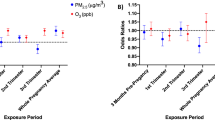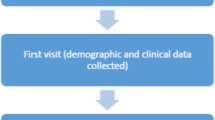Abstract
We sought to assess (1) the relationship between air particulate pollutants and feto-infant morbidity outcomes and (2) the impact of a Federal Healthy Start program on this relationship. This is a retrospective cohort study using de-identified hospital discharge information linked to vital records, and air pollution data from 2000 through 2007 for the zip codes served by the Central Hillsborough Federal Healthy Start Project in Tampa, Florida. Mathematical modeling was employed to compute minimal Euclidean distances to capture exposure to ambient air particulate matter. The outcomes of interest were low birth weight (LBW), very low birth weight (VLBW), small for gestational age, preterm (PTB), and very preterm birth. We used odds ratios to approximate relative risks. A total of 12,356 live births were analyzed. Overall, women exposed to air particulate pollutants were at elevated risk for LBW (AOR = 1.24; 95% CI = 1.07–1.43), VLBW (AOR = 1.58; 95% CI = 1.09–2.29) and PTB (AOR = 1.18; 95% CI = 1.03–1.34). Analysis by race/ethnicity revealed that the adverse effects of air particulate pollutants were most profound among black infants. Infants of women who received services provided by the Central Hillsborough Federal Healthy Start Project experienced improved feto-infant morbidity outcomes despite exposure to air particulate pollutants. Environmental air pollutants represent important risk factors for adverse birth outcomes, particularly among black women. Multi-level interventional approaches implemented by the Central Hillsborough Federal Healthy Start were found to be associated with reduced likelihood for feto-infant morbidities triggered by exposure to ambient air particulate pollutants.


Similar content being viewed by others
References
Rich, D. Q., Demissie, K., Lu, S.-E., et al. (2009). Ambient air pollutant concentrations during pregnancy and the risk of fetal growth restriction. Journal of Epidemiology and Community Health, 63, 488–496.
Parker, J. D., Woodruff, T. J., Basu, R., et al. (2005). Air pollution and birth weight among term infants in California. Pediatrics, 115, 121–128.
Lee, B. E., Ha, E. H., Park, H. S., et al. (2003). Exposure to air pollution during different gestational phases contributes to risks of low birth weight. Human Reproduction, 18, 638–643.
Hansen, C., Neller, A., Williams, G., et al. (2007). Low levels of ambient air pollution during pregnancy and fetal growth among term neonates in Brisbane, Australia. Environmental Research, 103, 383–389.
Gehring, U., van Eijsden, M., Dijkema, M. B. A., et al. (2011). Traffic-related air pollution and pregnancy outcomes in the Dutch ABCD birth cohort study. Occupational and Environmental Medicine, 68(1), 36–43.
Gouveia, N., Bremner, S. A., et al. (2004). Association between ambient air pollution and birth weight in Sao Paulo, Brazil. Journal of Epidemiology and Community Health, 58(1), 11–17.
Ballester, F., Estarlich, M., Iñiguez, C., et al. (2010). Air pollution exposure during pregnancy and reduced birth size: A prospective birth cohort study in Valencia, Spain. Environmental Health, 9, 6.
Bell, M. L., Ebisu, K., & Belanger, K. (2007). Ambient air pollution and low birth weight in Connecticut and Massachusetts. Environmental Health Perspectives, 115(7), 1118–1124.
Srám, R. J., Binková, B., Dejmek, J., et al. (2005). Ambient air pollution and pregnancy outcomes: A review of the literature. Environmental Health Perspectives, 113(4), 375–382.
Brauer, M., Lencar, C., Tamburic, L., et al. (2008). A cohort study of traffic-related air pollution impacts on birth outcomes. Environmental Health Perspectives, 116(5), 680–686.
Dugandzic, R., Dodds, L., Stieb, D., et al. (2006). The association between low level exposures to ambient air pollution and term low birth weight: A retrospective cohort study. Environmental Health, 5, 3.
Maisonet, M., Correa, A., Misra, D., et al. (2004). A review of the literature on the effects of ambient air pollution on fetal growth. Environmental Research, 95(1), 106–115.
Ren, C., Melly, S., & Schwartz, J. (2010). Modifiers of short-term effects of ozone on mortality in eastern Massachusetts—a case-crossover analysis at individual level. Environmental Health, 9, 3.
Hansen, C. A., Barnett, A. G., Jalaludin, B. B., et al. (2009). Ambient air pollution and birth defects in Brisbane, Australia. PLoS One, 4(4), e5408.
Ritz, B., Yu, F., Fruin, S., et al. (2002). Ambient air pollution and risk of birth defects in Southern California. American Journal of Epidemiology, 155(1), 17–25.
Ritz, B., Wilhelm, M., Hoggatt, K. J., et al. (2007). Ambient air pollution and preterm birth in the Environment and Pregnancy Outcomes Study at the University of California, Los Angeles. American Journal of Epidemiology, 166, 1045–1052.
Hansen, C., Neller, A., Williams, G., et al. (2006). Maternal exposure to low levels of ambient air pollution and preterm birth in Brisbane, Australia. British Journal of Obstetrics and Gynaecology, 113(8), 935–941.
Huynh, M., Woodruff, T. J., Parker, J. D., et al. (2006). Relationships between air pollution and preterm birth in California. Paediatric and Perinatal Epidemiology, 20(6), 454–461.
Wu, J., Ren, C., Delfino, R. J., et al. (2009). Association between local traffic-generated air pollution and preeclampsia and preterm delivery in the south coast air basin of California. Environmental Health Perspectives, 117(11), 1773–1779.
Glinianaia, S. V., Rankin, J., Bell, R., et al. (2004). Particulate air pollution and fetal health: A systematic review of the epidemiologic evidence. Epidemiology, 15(1), 36–45.
Yi, O., Kim, H., & Ha, E. (2009). Does area level socioeconomic status modify the effects of PM(10) on preterm delivery? Environmental Research, 110(1), 55–61.
El-Mohandes, A. A., Kiely, M., Blake, S. M., et al. (2010). An intervention to reduce environmental tobacco smoke exposure improves pregnancy outcomes. Pediatrics, 125, 721–728.
Salihu, H. M., Mbah, A. K., Jeffers, D., et al. (2009). Healthy start program and feto-infant morbidity outcomes: Evaluation of program effectiveness. Maternal and Child Health Journal, 13(1), 56–65.
US Census Bureau. (2003). State and county facts. Available at: http://www.census.gov/.
Mbah, A. K., Alio, A. P., Marty, P. J., Bruder, K., Wilson, R., & Salihu, H. M. (2011). Recurrent versus isolated pre-eclampsia and risk of feto-infant morbidity outcomes: Racial/ethnic disparity. European Journal of Obstetrics, Gynecology, and Reproductive Biology, 156(1), 23–28.
Salihu, H. M., Stanley, K. M., Mbah, A. K., August, E. M., Alio, A. P., & Marty, P. J. (2010). Disparities in rates and trends of HIV/AIDS during pregnancy across the decade, 1998–2007. Journal of Acquired Immune Deficiency Syndromes, 55(3), 391–396.
Environmental Protection Agency. (2011). USA air quality system. Available at: http://www.epa.gov/ttn/airs/airsaqs/.
Alexander, G. R., Kogan, M., Martin, J., & Papiernik, E. (1998). What are the fetal growth patterns of singletons, twins, and triplets in the United States? Clinical Obstetrics and Gynecology, 41, 114–125.
Taffel, S., Johnson, D., & Heuser, R. (1982). A method of imputing length of gestation on birth certificates. Vital Health Statistics, 2(93), 1–11.
Alexander, G. R., & Kotelchuck, M. (1996). Quantifying the adequacy of prenatal care: A comparison of indices. Public Health Report, 3, 408–418.
Kahn, E. B., Berg, C. J., & Callaghan, W. M. (2009). Cesarean delivery among women with low-risk pregnancies: A comparison of birth certificates and hospital discharge data. Obstetrics and Gynecology, 113(1), 33–40.
Lydon-Rochelle, M. T., Holt, V. L., Cárdenas, V., Nelson, J. C., Easterling, T. R., Gardella, C., et al. (2005). The reporting of pre-existing maternal medical conditions and complications of pregnancy on birth certificates and in hospital discharge data. American Journal of Obstetrics and Gynecology, 193(1), 125–134.
Kuzawa, C. W., & Sweet, E. (2009). Epigenetics and the embodiment of race: Developmental origins of US racial disparities in cardiovascular health. American Journal of Human Biology, 21(1), 2–15.
Burris, H. H., & Collins, J. W. (2010). Race and preterm birth—the case for epigenetic inquiry. Ethnicity and Disease, 20(3), 296–299.
Cutfield, W. S., Hofman, P. L., Mitchell, M., et al. (2007). Could epigenetics play a role in the developmental origins of health and disease? Pediatric Research, 61(5), 68R–75R.
Mitchell, M. D. (2006). Unique suppression of prostaglandin H synthase-2 expression by inhibition of histone deacetylation, specifically in human amnion but not adjacent choriodecidua. Molecular Cell Biology, 17(1), 549–553.
Dolinoy, D. C., Weidman, J. R., & Jirtle, R. L. (2007). Epigenetic gene regulation: Linking early developmental environment to adult disease. Reproductive Toxicology, 23(3), 297–307.
Porter, T. F., Fraser, A. M., Hunter, C. Y., et al. (1997). The risk of preterm birth across generations. Obstetrics and Gynecology, 90(1), 63–67.
Woodruff, T. J., Grillo, J., & Schoendorf, K. C. (1997). The relationship between selected causes of postneonatal infant mortality and particulate air pollution in the United States. Environmental Health Perspective, 105(6), 608–612.
van den Hooven, E. H., Jaddoe, V. W., de Kluizenaar, Y., et al. (2009). Residential traffic exposure and pregnancy-related outcomes: A prospective birth cohort study. Environmental Health, 8, 59.
Mannes, T., Jalaludin, B., Morgan, G., et al. (2005). Impact of ambient air pollution on birth weight in Sydney, Australia. Occupational and Environmental Medicine, 62(8), 524–530.
Salam, M. T., Millstein, J., Li, Y. F., et al. (2005). Birth outcomes and prenatal exposure to ozone, carbon monoxide, and particulate matter: Results from the Children’s Health Study. Environmental Health Perspective, 113(11), 1638–1644.
Shaw, G. M., & Malcoe, L. H. (1992). Residential mobility during pregnancy for mothers of infants with or without congenital cardiac anomalies: A reprint. Archives of Environmental Health, 47(3), 236–238.
Canfield, M. A., Ramadhani, T. A., Langlois, P. H., et al. (2006). Residential mobility patterns and exposure misclassification in epidemiologic studies of birth defects. Journal of Exposure Science and Environmental Epidemiology, 16(6), 538–543.
Fell, D. B., Dodds, L., & King, W. D. (2004). Residential mobility during pregnancy. Pediatric and Perinatal Epidemiology, 18(6), 408–414.
Khoury, M. J., Stewart, W., Weinstein, A., et al. (1988). Residential mobility during pregnancy: Implications for environmental teratogenesis. Journal of Clinical Epidemiology, 41(6), 15–20.
Author information
Authors and Affiliations
Corresponding author
Rights and permissions
About this article
Cite this article
Salihu, H.M., August, E.M., Mbah, A.K. et al. Effectiveness of a Federal Healthy Start Program in Reducing the Impact of Particulate Air Pollutants on Feto-Infant Morbidity Outcomes. Matern Child Health J 16, 1602–1611 (2012). https://doi.org/10.1007/s10995-011-0854-1
Published:
Issue Date:
DOI: https://doi.org/10.1007/s10995-011-0854-1




